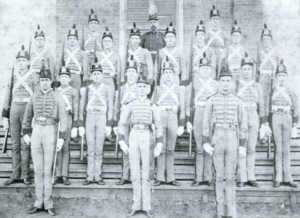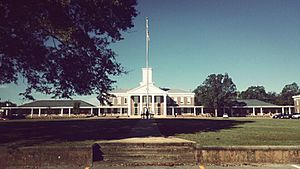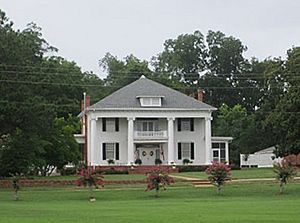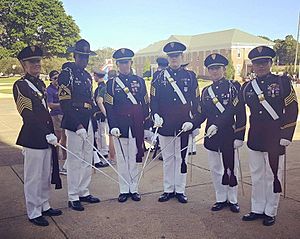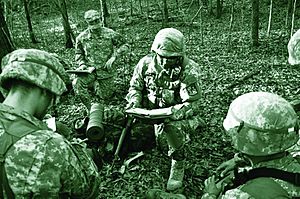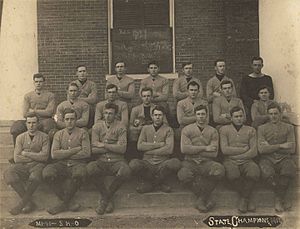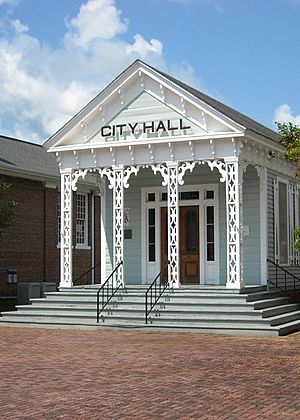Marion Military Institute facts for kids
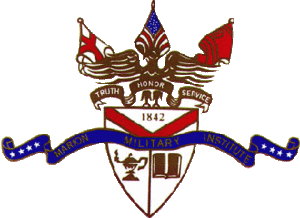 |
|
| Motto | Truth, Honor, Service |
|---|---|
| Type | Public military junior college |
| Established | 1842 |
| Founder | James T. Murfee |
|
Parent institution
|
Alabama Community College System |
| Accreditation | SACS |
|
Academic affiliations
|
AMCSUS |
| President | Colonel David J. Mollahan, USMC (Ret.) |
| Commandant | Colonel Edwin W. Passmore, USA (Ret.) |
|
Academic staff
|
20 Full-time & 6 Part-time |
| Students | 320 |
| Location |
,
,
United States
32°37′25″N 87°19′16″W / 32.6237°N 87.3211°W |
| Campus | Rural, 160 acres (0.65 km2) |
| Colors | Orange and black |
|
Sporting affiliations
|
NJCAA Division I – ACCC |
| Mascot | Tigers |
Marion Military Institute (MMI), also known as the Military College of Alabama, is a public two-year college in Marion, Alabama. It was started in 1842. MMI is the official state military college of Alabama. It is also the oldest military junior college in the United States.
MMI is one of only four military junior colleges in the country. These schools offer special programs for students who want to join the military. One program is the Army's two-year Early Commissioning Program (ECP). In this program, qualified students can become a Second Lieutenant in the Army after just two years of college. MMI's ECP is one of the best in the U.S. Army.
Another program is the Service Academy Program (SAP). This program helps students prepare for their first year at one of the U.S. Service Academies. All five Service Academies support and choose students for this program. MMI also has programs for the Marine Corps and the Air Force Reserve Officer Training Corps. Over the years, more than 200 generals and admirals in the United States Armed Forces have studied at MMI.
MMI is approved by the Southern Association of Colleges and Schools Commission on Colleges. This means it can give out Associate of Arts and Associate of Science degrees. It is also part of the Association of Military Colleges and Schools of the United States.
Marion Military Institute is recognized as an Alabama Historical Marker. It has two buildings listed on the National Register of Historic Places. These are the MMI Chapel and Lovelace Hall, and the President's House. The Alabama Military Hall of Honor is also on campus. It was created in 1975.
Contents
History of Marion Military Institute
Marion Military Institute began in 1842. It started as Howard College in Marion, Alabama. During the American Civil War, some of its buildings were used as a hospital. These buildings, like Lovelace Hall and the chapel, are now on the National Register of Historic Places.
In 1887, Howard College moved to Birmingham. However, the president of Howard College, Colonel J. T. Murfee, decided to stay in Marion. He and some teachers and students started Marion Military Institute. It was a military high school and college. It was designed like Murfee's old school, Virginia Military Institute.
MMI became well-known under its second president, H. O. Murfee. President William Howard Taft was even on its board of trustees. In 1916, the United States Army ROTC program started at MMI. The school was called an "Honor Military School with Distinction."
The U.S. Army Early Commissioning Program began at MMI in 1968. In 1971, MMI started accepting both male and female students. In 2006, the Alabama state government made MMI "the State Military College of Alabama." Because of this, MMI stopped its high school program. The last high school class graduated in May 2009.
How Cadets are Organized
The students at MMI are called cadets. They are organized into a group called a battalion. This battalion has a Headquarters staff and six companies: Band, A, B, C, D, and E. A cadet lieutenant colonel leads the whole battalion.
Each company has its own leaders. A cadet captain is in charge of each company. There is also a cadet first lieutenant who helps lead. Each company has two cadet second lieutenants who lead smaller groups called platoons. There are also cadet first sergeants and cadet sergeant first class members who help lead. Each platoon has smaller groups called squads, led by a cadet staff sergeant.
Sports at MMI
The sports teams at Marion Military Institute are called the "Tigers." They are part of the Alabama Community College Conference (ACCC). This conference is part of the National Junior College Athletic Association (NJCAA) Division I.
MMI currently has teams for baseball, men's basketball, softball, tennis, cross country, and golf. The school's colors used to be pink and green. But they were changed to orange and black after Woodrow Wilson visited the school. MMI chose the tiger as its mascot to honor Princeton University.
In the 2015–2016 season, the MMI men's basketball team won their first ACCC Basketball Championship. They also played in the NJCAA Men's National Basketball Championships. The men's tennis team has been very strong in Alabama. They won the NJCAA Region XXII Championship five years in a row from 2011 to 2016.
MMI also used to have a football team. They won the state championship in 1912. In 1918, MMI's football team won a game 101–0. This was their biggest win ever. In 1922, the University of Alabama beat MMI 110–0. This is still the biggest win for the University of Alabama's football team.
Past Presidents of MMI
Sixteen people have served as president of Marion Military Institute.
| No. | Portrait | Name | Term | Notes |
|---|---|---|---|---|
| 1 | 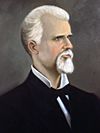 |
J.T. Murfee | 1887–1906 | Former lieutenant colonel in the CSA. He was the first captain of VMI Class of 1853. |
| 2 | 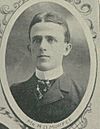 |
H.O. Murfee | 1906–1919 | |
| 3 |  |
W.L. Murfee | 1919–1944 | |
| 4 | – | J.T. Murfee II | 1944–1953 | |
| 5 | – | Linton H. Baer | 1953–1954 | |
| 6 | – | Robert Calhoun Provine | 1954–1958 | |
| 7 | 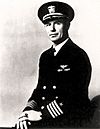 |
Cato D. Glover | 1958–1959 | An Admiral in the U.S. Navy (retired). |
| 8 | – | Paul B. Robinson | 1959–1973 | |
| 9 | 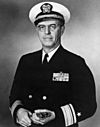 |
Draper Kauffman | 1974–1976 | A Rear admiral in the U.S. Navy (retired). |
| 10 | – | Thomas H. Barfield | 1976–1983 | A Major general in the U.S. Army (retired). He was in the Class of 1935. |
| 11 | – | Clyde W. Spence | 1983–1990 | A Major general in the U.S. Army (retired). He was in the Class of 1946. |
| 12 | – | Joseph L. Fant III | 1990–1994 | A Major general in the U.S. Army (retired). He was in the Class of 1947. |
| 13 | 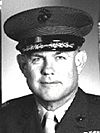 |
Wayne T. Adams | 1994–1998 | A Brigadier general in the U.S. Marine Corps (retired). He was in the Class of 1960. |
| vacancy | 1998–2000 | |||
| 14 | 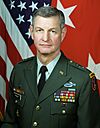 |
Robert F. Foley | 2000–2004 | A Lieutenant general in the U.S. Army (retired). He received the Medal of Honor. |
| 15 | – | James H. Benson | 2004–2009 | A Colonel in the U.S. Marine Corps (retired). |
| 16 |  |
David J. Mollahan | 2009–present | A Colonel in the U.S. Marine Corps (retired). |
Famous People Who Attended MMI
Early Commissioning Program Graduates
- Robert W. Bennett, U.S. Army brigadier general
- Jeff Brandes, a politician in Florida
- Emerson Brooks, an actor
- Scott L. Efflandt, U.S. Army major general
- Clark W. LeMasters, Jr., U.S. Army major general
- Terry F. Moorer, a judge
- Shawn Morelli, a Paralympic gold medalist in cycling
- Raymond F. Shields Jr., U.S. Army major general
Service Academy Program Graduates
- Paul D. Adams, U.S. Army general
- John Bahnsen, U.S. Army brigadier general
- José M. Cabanillas, U.S. Navy rear admiral
- Robert E. Hogaboom, Chief of Staff of United States Marine Corps
- Bruce K. Holloway, USAF general
- Harold Houser, U.S. Navy rear admiral
- Clayton C. Jerome, USMC naval aviator
- Alexander Kreiser, USMC brigadier general
- Halley G. Maddox, U.S. Army major general
- Merlin O'Neill, 10th commandant of the Coast Guard
- William W. Outerbridge, U.S. Navy rear admiral
- Jacob E. Smart, USAF general
- Thomas Walker, U.S. Navy vice admiral
Other Notable Alumni
- Mike Carey, a member of the U.S. House of Representatives
- Bernard Ford, a former NFL player
- Miller Reese Hutchison, an electrical engineer and inventor
- Maston E. O'Neal, Jr., a member of the U.S. House of Representatives
- Jimmy Rane, founder and CEO of Great Southern Wood Preserving
- Eugene Sledge, a U.S. Marine, professor, and author
- Tom Stagg, a judge
- Dwight Stone, a former NFL player
- Robert H. York, U.S. Army lieutenant general
See also



